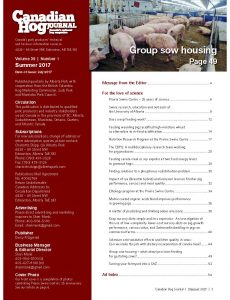Articles in the Summer 2017 Canadian Hog Journal include:
For the Love of Science:
Does Creep Feeding Work?
- Creep feeding is done to help alleviate problems at weaning, but most results are inconclusive. This study found that creep feeding is beneficial to the piglets that eat it, but consumption rates remain low.
Feeding Weanling Pigs Acidified High-Moisture Wheat as Alternative to In-Feed Acidification
- Weaning diets are commonly supplemented with “acidifiers” to help protein digestion. Acidified high-moisture wheat may be an alternative. Performance was not affected by using this feed.
Nutrition Research Program at Prairie Swine Centre
- Nutrition-based alternatives to antibiotic use are being explored. Dietary protein and fibre and immune challenge on amino acid requirements in growing pigs are being determined.
The CDPQ: A Multidisciplinary Research Team Working for Pig Producers
- The Centre de development du porc du Quebec inc. serves the swine sector through difference services, projects and programs. Ongoing projects include group housing sows, finisher pig feeding behaviour and water wastage, improving air filtration, ozonation to reduce pathogens and infrared thermography.
Feeding Canola Meal or Soy Expeller at Two Feed Energy Levels to Growout Hogs
- Profitability increased and performance was unchanged when feeding lower net energy diets. Soy expeller diets were more palatable and introducing the 25% canola meal in grower phase diets was challenging to the hogs.
Finding Solutions to a Phosphorus Redistribution Problem
- Research from the Manitoba Livestock Manure Management Initiative looks at managing and treating phosphorous in high livestock intensity areas. A two-cell earthen manure storage system can separate phosphorus from manure. Gravity settling is also beneficial.
Impact of Rye (Brasetto Hybrid) and Inclusion Level on Finisher Pig Performance, Carcass and Meat Quality
- Rye can be used as an alternative to wheat and barley especially when used in moderate levels in a step-up pattern. Ergot contamination does decrease performance.
Ethology Program at the Prairie Swine Centre
- Research often relates to anticipating consumer issues and evolving standards of production, related to the Code of practice for the care and handling of pigs. Castration pain control, enrichment for sows, space allowances, group housing transitioning and transportation conditions are all involved.
Matrix Coated Organic Acids Blend Improves Performance in Growing Pigs
- Metabolism and absorption of organic acids in the small intestine are improved. May be beneficial in antibiotic-free feeding regimens.
A Matter of Predicting and Limiting Odour Emissions
- The odour impact assessment tool (OIAT) was developed that estimates emissions, predicts odour exposure and includes odour acceptability from the community. This will help decrease new swine barns negative effects on the nearby community.
Keep Nursery Diets Simple and Less Expensive
- Using low-complexity nursery diets on commercial farms had no negative effects on lifetime growth performance or carcass traits. Salmonella shedding needs to be further investigated.
Selenium Anti-Oxidative Effects and Litter Quality in Sows: Can we Make the Job with Dietary Incorporation of Canola Meal ?
- The antioxidant selenium is often supplemented, but it can be supplied organically through canola meal due to its high selenium levels.
Group Sow Housing – What About Precision Feeding for Gestating Sows?
- Precision feeding involves using two feed ingredients, one rich in nutrients and one not, and is administered through electronic sow feeder-type (ESF) feeding systems. Lysine requirements are better targeted. Reduction in overfeeding in multiparous sows is a benefit as well. Reducing excess nutrients save $3 per sow per year.
Turning your Farmyard into a CAZ
- A Controlled Access Zone (CAZ) prevents vehicles from entering the farm’s yard. Key fob entry, intercoms or automated barrier arm gates can be used to let authorized personnel in. Dedicated yard boots or disposable booties should be used to decrease the spread of pathogens.
Summer-2017 (full journal)
